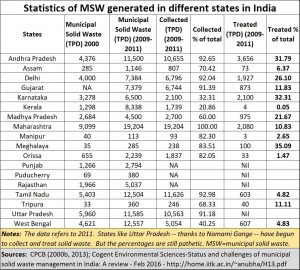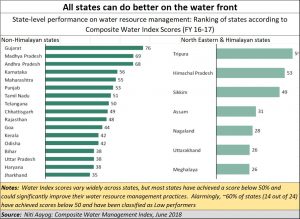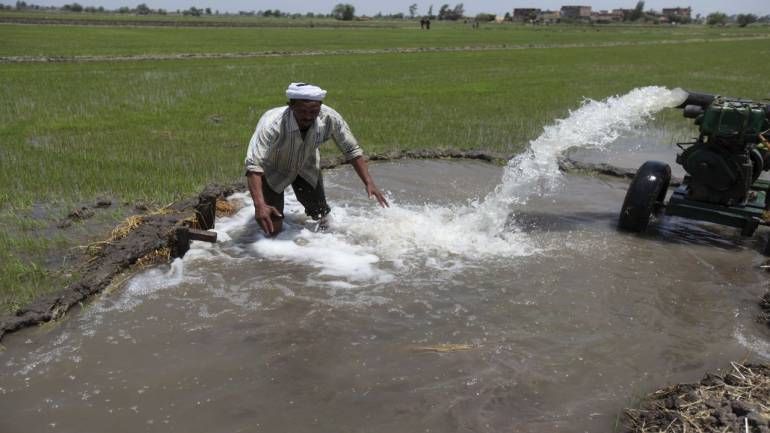https://www.moneycontrol.com/news/india/climate-change-depleting-reservoirs-and-the-blindness-to-water-treatment-and-recycling-4135311.html
Water series 6 – Other articles in this series are listed below
Climate change & depleting reservoirs make water treatment and recycling more urgent
RN Bhaskar — June 25, 2019
The buzz is about climate change. And it is likely that both agriculture and water availability will be severely hit, unless the right measures are taken immediately. Unseasonal rains and excessive heat affect crop productivity adversely. Finally, as ground water resources get depleted, water scarcity will become excruciatingly painful.
Uma Aslekar, who works on groundwater with an NGO called ACWADAM, headquartered in Pune, puts it succinctly (https://www.freepressjournal.in/mumbai/turning-the-focus-on-water) “Groundwater is one of the most ignored subjects in Maharashtra, as well as in India. We cannot ignore groundwater, because more than 90% to 95% of our public water supply schemes are based on groundwater.”
She points out how 65% of irrigation is groundwater-based in India (in Maharashtra it is 95%). “It’s very difficult for people to understand this, because it’s a source which is out of sight and hence, often, out of mind as well,” she adds. “We need to make people aware about the concept of aquifers.” As the entire world gets racked by climate change, at least two-thirds of humanity which currently lives in zones that experience water scarcity for at least one month a year will find water more difficult to come by. Unless new methods are adopted to gather water, treat it, and recycle it.
That is why, the check-dams-strategy that Narendra Modi advocated and got implemented while he was chief minister of Gujarat (http://www.asiaconverge.com/2010/05/narendra-modis-farm-miracle/) needs to be commended and even replicated. Ditto with the jal yukt shivir programme launched by the Maharashtra chief minister Devendra Fadnavis (though this has often been misused – https://www.moneycontrol.com/news/india/water-water-everywhere-nor-any-drop-to-drink-4082681.html).
The need for water conservation assumes paramount significance because of changing rainfall patterns. Drought cycles are becoming more frequent. Maharashtra alone witnessed drought in 2012, 2015 and now in 2019. Earlier it used to rain for 40-45 days. Today, rainfall occurs for just 15 days – though with greater intensity. So while earlier, water had the time to lazily flow through fields and soak into the ground, today you have bigger runoffs, causing water to flow into drqains and then into the sea. Maharashtra’s disastrous cropping pattern focussing on sugarcane also adds to the crisis, and is primarily responsible for over 12.021 farmer suicides during the past four years (https://www.moneycontrol.com/news/india/maharashtras-criminally-reckless-water-management-and-its-industry-unfriendly-moves-3138561.htmlMoneycontrol).
Sewage uncontrolled
Nothing destroys groundwater as quickly as untreated sewage and industrial effluents. This is another area that India has ignored, much to its own peril. As pointed out earlier in this water series (https://www.moneycontrol.com/news/world/water-usage-lessons-india-should-learn-from-china-4026441.html), India is blessed with more water than many Asian countries. But it has misused and abused water to the point where it has become scarce and is now causing death and destruction.
 SwachIndia, of NDTV.com,,tainly puts this across quite well (https://swachhindia.ndtv.com/wastewater-recycling-multi-billion-dollar-opportunity-india-avoid-forthcoming-water-crisis-7182/). “India is the biggest consumer of freshwater in the world today, accounting for about 750 billion cubic metres annually . . . For a country which accounts for only 4 per cent of the world’s water resources despite hosting 17 per cent of the world’s population, the water crisis is a looming danger we should be wary of. The Central Pollution Control Board (CPCB) estimates that by 2030, India’s water demand is expected to rise to 1.5 trillion cubic metres.”
SwachIndia, of NDTV.com,,tainly puts this across quite well (https://swachhindia.ndtv.com/wastewater-recycling-multi-billion-dollar-opportunity-india-avoid-forthcoming-water-crisis-7182/). “India is the biggest consumer of freshwater in the world today, accounting for about 750 billion cubic metres annually . . . For a country which accounts for only 4 per cent of the world’s water resources despite hosting 17 per cent of the world’s population, the water crisis is a looming danger we should be wary of. The Central Pollution Control Board (CPCB) estimates that by 2030, India’s water demand is expected to rise to 1.5 trillion cubic metres.”
India can certainly avoid water-riots if it manages water well – the way China and Israel have. Unlike them, India recycles only 30% of its waste water. But even this figure is generous. In many states, barely 5% of the solid waste generated gets collected and treated. In fact, the highest figure comes to around 30% (see chart alongside).
Effluent treatment
All waste invariably goes underground and contaminates ground water reserves. And this becomes more serious when one deals with industrial waste, because it has more contaminants that can kill and maim future generations. Unfortunately, the present state of effluent treatment and monitoring can be very messy because, as the Madhav Gadgil report on environment in the Western Ghats of India points out (https://www.researchgate.net/publication/325114270_PROTECTION_OF_WESTERN_GHATS_AND_GADGIL_REPORT), some industrial units even try to escape treatment of effluents by recklessly drilling holes in the ground and make the discharge disappear there. This has the potential of destroying countless generations of people in the vicinity.
Surprisingly, even though pollution control board officials have charts listing out input output ratios for almost all industries (hence know the approximate amount of effluent the units must generate every day), there is immense collusion. Hardly any pollution control board official has been sacked for collusion or incompetence.
Moreover, there is no attempt to enforce the rule of polluter pays. India has yet to adopt the polluter-pays-principle. By paying more for more toxic or difficult-to-treat effluents, the onus is on companies which emit more hazardous pollutants. Instead India still prefers to adopt a single flat tariff for effluent treatment from all units in an industrial zone – and even this is not paid for fully.
Thus, sewage discharge continue to grow. According to ENVIS Centre on Hygiene, Sanitation, Sewage Treatment Systems and Technology (http://www.sulabhenvis.nic.in/Database/STST_wastewater_2090.aspx) India produces a total sewage of 61,754 MLD (million litres daily), and untreated sewage of 38,791 MLD. Against this, the total sewage treatment capacity is only 22,963 MLD or 23% of the sewage output.
 According to the UN World Water Development Report, while wastewater treatment levels can reach 70 per cent in high-income countries, the ratio in upper-middle-income and in lower-middle-income countries drops to 38 per cent and 28 per cent, respectively. Thus the figures given above (23%) are even lower. The only saving grace is that India does not resemble a low-income country where only 8 % of industrial and municipal wastewater undergoes treatment of any kind.
According to the UN World Water Development Report, while wastewater treatment levels can reach 70 per cent in high-income countries, the ratio in upper-middle-income and in lower-middle-income countries drops to 38 per cent and 28 per cent, respectively. Thus the figures given above (23%) are even lower. The only saving grace is that India does not resemble a low-income country where only 8 % of industrial and municipal wastewater undergoes treatment of any kind.
Unfortunately, much of India’s sewage gets discharged directly into rivers or lakes. That explains why the Ganges and the Yamuna are so polluted. It is cheaper and easier to stop sewage discharge into the rivers, than it is to clean them. India has often ignored the former.
The UN states that over 800,000 people die every year because of contaminated drinking water, and not being able to properly wash their hands. Water-related diseases claim nearly 3.5 million lives annually in Africa, Asia and Latin America — more than the global death toll from AIDS and car crashes combined. More details on the views of the UN can be found from The United Nations World Water Development Report 2019 (https://unesdoc.unesco.org/92ecbb61-7cb8-4b13-ad85-7b0854dae99f/367306eng.pdf).
Even so, most states have a terrible record when it comes to water management. As a Niti Aayog document shows (see chart), more than 60% of the states score less than 50% on the water management front. This needs to change. And even while the UN expects to halve the proportion of untreated wastewater and increase safe water reuse worldwide, India will first have to work towards better legislation, better compliance and more enforcement of severe penalties for any disrespect for water by bureaucrat or consumer.
This is where new policies need to be crafted. Fortunately, there is plenty of money to be made from water and waste management. And from new technologies in agriculture.
But more on that later.
Articles in this series:
Water Series 1 – http://www.asiaconverge.com/2019/05/india-faces-a-water-crisis-of-its-opwn-making/ – India’s rapidly deteriorating water crisis
Water series 2 – http://www.asiaconverge.com/2019/05/india-should-learn-water-management-from-china/ — Lessons to learn from China
Water series 3 — http://www.asiaconverge.com/2019/06/the-stranglehold-of-the-water-tanker-mafia/ — The stranglehold of the tanker-mafia
Water series 4 — http://www.asiaconverge.com/2019/06/india-faces-water-shortage-despite-abundance/ — Water, water everywhere// Nor any drop to drink
Water series 5 — http://www.asiaconverge.com/2019/06/crisis-helps-review-water-policies/ — Crisis alone can make water policies change
Water series 6 — http://www.asiaconverge.com/2019/06/climate-change-depleting-reservoirs-and-the-blindness-to-water-treatment-and-recycling/ — Climate-change, depleting reservoirs and the blindness to water treatment and recycling
Water series 7 — http://www.asiaconverge.com/2019/07/how-india-forgot-its-water-footprint/ — How India forgot its water-footprint
Water series 8 — http://www.asiaconverge.com/2019/07/india-faces-no-scarcity-of-water/ — Water scarcity is a myth India loves to propagate
Water series 9 – http://www.asiaconverge.com/2019/07/the-govt-fails-in-water-harvesting-and-waste-management/ — The govt slips up badly on waste management, even water harvesting
Water series 10 — http://www.asiaconverge.com/2019/07/water-and-waste-management-key-to-pm-plans/ — Petty graft could sabotage water and waste management and even the PM’s biggest schemes
Water series 11 — http://www.asiaconverge.com/2019/07/niti-aayog-is-promoting-desalination-which-is-irrelevant-expensive-and-polluting/ — Desalination: Niti Aayog shouldn’t push a solution that is irrelevant, expensive and polluting
Water Series 12 — http://www.asiaconverge.com/2019/08/desalination-is-a-money-game-in-india/ — Desalination is a big money game baby!






































COMMENTS